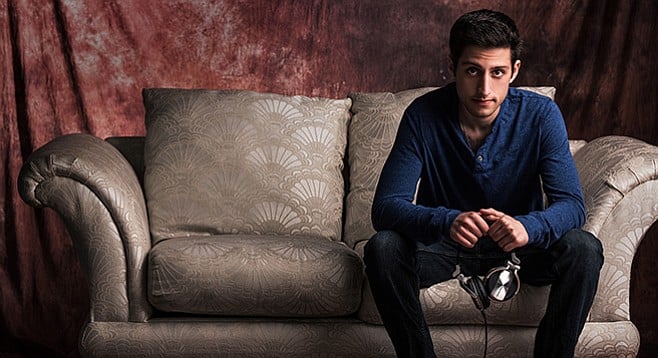 Facebook
Facebook
 X
X
 Instagram
Instagram
 TikTok
TikTok
 Youtube
Youtube

It’s the best of times, it’s the worst of times — for electronic dance music.
“EDM has become so huge in San Diego that we get some of the biggest artists, like Oliver Heldens, coming here for a long residency.”
That according to EDM artist Naveed Moein, who says the success of the techno mecca Omnia has established San Diego as a destination point for world-famous EDM artists.
As DJ CodeBlue, Moein presented his own progressive house/trance body of work at local venues. His work drew the attention of Z90’s Hot Shot local-talent segment, which plays five tracks of unsigned artists each weekday night. On the fifth day, one local artist “wins” that week based on votes from Z90 listeners. “Right now I have 20,000 votes and [San Diego hip-hop artist] Heartbreaka is a few hundred votes behind me,” he says of this week’s Hot Shot round.
As of last week, CodeBlue’s “Grobby” had won two Hot Shot segments in a row.
But Moein says because of what local EDM producers have to do to perform live, artists like him have walked away from local venues like Bassmnt.
“I know a lot of producers like me who have been shut down. They just gave up.”
He says the local EDM venues have slid into a routine that parallels the pay-to-play model used for many local bands.
“It used to be they cared how good you were. Now you get a spot depending on how many tickets you sell in advance. That drove away a lot of talent who would normally get involved.”
Moein says the promoter’s job is best handled by people who like to promote.
“I don’t think it should be the artist’s job to have to sell tickets.”
He says this “disrespect” is why he literally went deep house — his own house.
“Bedroom DJs strictly stay in their bedroom. They depend on people listening to their music online and hope their music goes viral.”
Moein, 21, is studying to be a computer systems analyst. He started playing the piano and dulcimer at age five and says he has always been fascinated by computer-generated sounds. He doesn’t use turntables when he exhibits his music, which fuses musical theory and computer technology.
“The entire industry has completely shifted online,” says Moein. According to him, EDM now thrives on iTunes and Spotify. “Soundcloud has helped me get where I am.”
Moein says the Worldbeat Center and the now-closed Epicentre once fostered healthy EDM scenes, and that successful EDM artists Jason Ross and Ookay launched their careers from San Diego.
“The best place for a person like me to play in public is Europe, where EDM originated. It’s easy to go play in a club in Europe.”


It’s the best of times, it’s the worst of times — for electronic dance music.
“EDM has become so huge in San Diego that we get some of the biggest artists, like Oliver Heldens, coming here for a long residency.”
That according to EDM artist Naveed Moein, who says the success of the techno mecca Omnia has established San Diego as a destination point for world-famous EDM artists.
As DJ CodeBlue, Moein presented his own progressive house/trance body of work at local venues. His work drew the attention of Z90’s Hot Shot local-talent segment, which plays five tracks of unsigned artists each weekday night. On the fifth day, one local artist “wins” that week based on votes from Z90 listeners. “Right now I have 20,000 votes and [San Diego hip-hop artist] Heartbreaka is a few hundred votes behind me,” he says of this week’s Hot Shot round.
As of last week, CodeBlue’s “Grobby” had won two Hot Shot segments in a row.
But Moein says because of what local EDM producers have to do to perform live, artists like him have walked away from local venues like Bassmnt.
“I know a lot of producers like me who have been shut down. They just gave up.”
He says the local EDM venues have slid into a routine that parallels the pay-to-play model used for many local bands.
“It used to be they cared how good you were. Now you get a spot depending on how many tickets you sell in advance. That drove away a lot of talent who would normally get involved.”
Moein says the promoter’s job is best handled by people who like to promote.
“I don’t think it should be the artist’s job to have to sell tickets.”
He says this “disrespect” is why he literally went deep house — his own house.
“Bedroom DJs strictly stay in their bedroom. They depend on people listening to their music online and hope their music goes viral.”
Moein, 21, is studying to be a computer systems analyst. He started playing the piano and dulcimer at age five and says he has always been fascinated by computer-generated sounds. He doesn’t use turntables when he exhibits his music, which fuses musical theory and computer technology.
“The entire industry has completely shifted online,” says Moein. According to him, EDM now thrives on iTunes and Spotify. “Soundcloud has helped me get where I am.”
Moein says the Worldbeat Center and the now-closed Epicentre once fostered healthy EDM scenes, and that successful EDM artists Jason Ross and Ookay launched their careers from San Diego.
“The best place for a person like me to play in public is Europe, where EDM originated. It’s easy to go play in a club in Europe.”
Comments